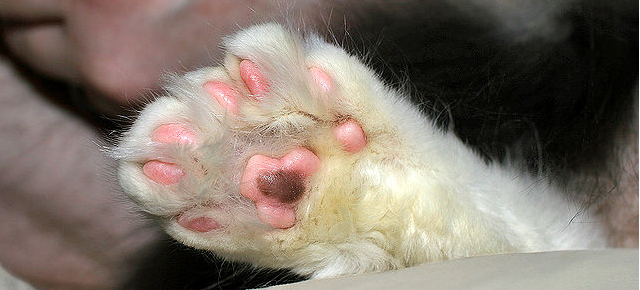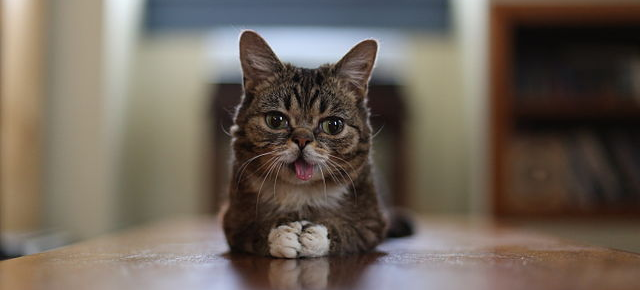A team of geneticists is ready to unlock the secrets behind Internet celebrity cat Lil Bub’s unique appearance. Lil Bub, whose full name is Lillian Bubbles (her friends call her Bub), may be the most recognisable cat on the Web. Although Bub is an adult now, she still looks like a kitten, with wide green eyes and short legs and her tongue sticks out, giving her a perpetual happy-go-lucky expression.
She has an extra toe on each foot, giving her a total of 22 toes and a worldwide fan base of about 1.9 million, according to Facebook.
When molecular biologist Danial Ibrahim shared a video of Bub with his colleagues Darío G. Lupiáñez and Orsolya Symmons, they were intrigued. They wanted to understand the genetic basis of Bub’s uniquely adorable looks, so they got in touch with her owner, Mike Bridavsky. He responded right away, according to the researchers, and was very enthusiastic about the idea.
The three scientists launched a campaign on science crowdfunding platform Experiment.com in order to raise the $US6500 needed to fully sequence Lil Bub’s genome. The project has met its funding goal, but the team hopes to raise additional funds over the next few days for its stretch goal of studying other rare genetic diseases in cats.
A Common Ancestor
It turns out that Bub is probably related to some other famous cats, owned by author Ernest Hemingway. Like Bub, Hemmingway’s cats had a genetic condition called polydactyly, giving them an extra toe on each paw. A 2007 study found evidence that all American polydactyl cats, also known as “Hemingway cats”, are probably related. Ibrahim explained that researchers in the 2007 study found that polydactyl cats in Britain shared a certain genetic mutation, while polydactyl cats in the U.S. shared a different mutation.
“From this, they hypothesized that all American cats must have a common ancestor, a founder cat who was polydactyl and then spread the trait across the US,” Ibrahim told Gizmodo.

Bridavsky sent the team a blood sample from Bub, which they checked for the polydactyly mutation – and they found the same mutation as the other American polydactl cats. That’s strong evidence that Bub is related, at least distantly, to the famous writer’s many-toed cats.
But Bub’s extra toes may be even more special than that. Most “Hemingway cats” only have extra toes on two paws, but Bub has extras on all four paws. “So it’s possible that there is something else somewhere in the genome that reinforces this basic polydactyly,” said Symmons, and the team wants to find it. “I think you can achieve certain things by looking at only little bits and pieces, which we’ve done for the Hemingway mutation, but I think we’ll see a lot more if we have the entire genome sequenced.”
In Her Bones
Bub has a very rare condition called osteopetrosis, a genetic condition that causes bone to become much more dense than it should be. The researchers only know of a few other cats who have been diagnosed with osteopetrosis, and their cases aren’t quite the same as Bub’s. Osteopetrosis also affects humans; in fact, it’s a little more common in humans than in cats, but it’s still pretty rare.
Because Bub’s owner rescued her from a shelter, not much is known about her parents, but the team says she probably didn’t inherit her osteopetrosis from her parents. In humans, the genetic mutation that causes the condition happens spontaneously, rather than being passed down from parents, and the same thing is likely in cats.
Thanks to her condition, Bub has shorter legs than most cats, and her movements are a little restricted, but it doesn’t seem to get her down; the researchers said that her vet describes her as a happy cat.
Osteopetrosis may also explain Bub’s distinctive facial expression. Symmons explained that the team thinks the rapid over-calcification of Bub’s bones happened before the bones of her jaws had a chance to finish growing, so she has a shorter snout than most cats. For the same reason, Bub’s teeth never grew out all the way, so she only has what Symmons describes as “little buds.”
But they won’t be sure until they get a closer look at Bub’s genome. “That’s something we probably will know more about if we can find the mutation and compare it to what the human phenotypes look like and those mutations,” said Symmons.
Rare Combination
Bub’s two rare genetic conditions don’t seem to be connected. The team thinks it’s just an incredible coincidence that she has both conditions. “It would be very, very weird if that [polydactyly] mutation caused osteopetrosis, because Hemingway’s cats had the same mutation, and so, we guess that she has just two individual mutations,” said Ibrahim.
Because Bub’s conditions are both so rare, there hasn’t been much work done on them. “Normally, in science, there is not that much funding for this type of disease,” said Lupiáñez. “People prefer to keep the funding for cancer or diabetes or things like that.” But the team thinks that crowdfunding is a good way to raise money for research on rare conditions, especially with a subject like Lil Bub, who has already attracted a lot of interest on the Internet.
It’s worthwhile to study rare diseases in cats because so much of the genetic material that regulates basic development is shared among all mammal species, so a lesson from LilBub might apply not only to other cats, but also to humans. “All of these diseases, the mechanism is shared basically between different mammals,” said Symmons. “LilBub is basically one piece of a puzzle, but she’s also connected to all these other cases.
Vets have found a treatment that helps Bub helps manage her osteopetrosis. Knowing the genetic cause of her condition could help other osteopetrosis patients with similar genetics – feline and, perhaps one day, human – get same treatment. It’s not as clear-cut as discovering a new drug treatment, but it is a piece of the puzzle, the team says.
“We also want people to get this message from this that science is not always having the specific answer right away, but it’s rather a process,” Lupiáñez told Gizmodo.
Stretch Goals
The project has raised $US7,100 so far. $US6,500 of that will go to pay for sequencing Lil Bub’s genome, and any additional money the team raises will support their next project: work with a research group called the 99catlives Initiative, which is studying another rare condition called hypertrophic cardiomyopathy.
It’s also genetic, but unlike Bub’s conditions, hypertrophic cardiomyopathy is life-threatening. “It happens in a number of cat breeds, and then these cats then eventually die from their heart just being too big and undernourished at too young an age,” said Ibrahim. The disease is passed to kittens from their parents, but scientists don’t know much else about its genetics – yet.
Image credit: Iamlilbub via Wikimeda Commons
